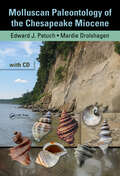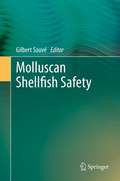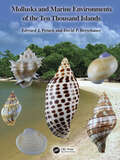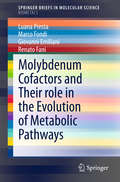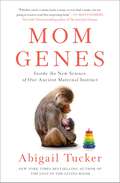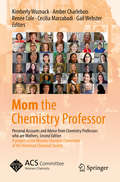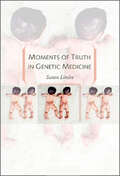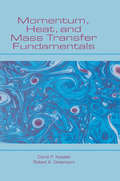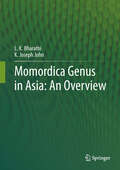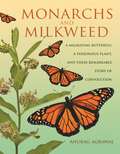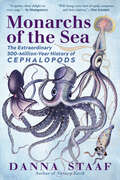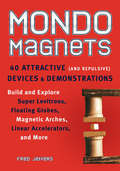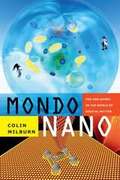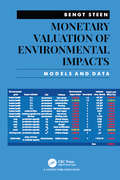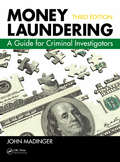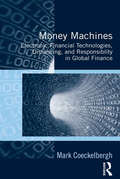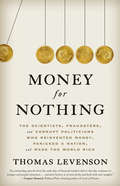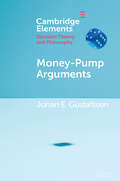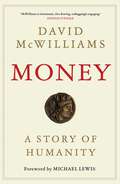- Table View
- List View
Molluscan Paleontology of the Chesapeake Miocene
by Edward J. Petuch Mardie DrolshagenThe Chesapeake Miocene will always be considered a paleontological treasure. Given the richness and accessibility of the Maryland and Virginia Miocene shell beds, it seems remarkable that very few people have ever described new species from these strata over the past 185 years. Until now. Integrating elements from paleontology, geology, environmental science, and ecology, Molluscan Paleontology of the Chesapeake Miocene assembles previous research and the authors’ experience into a synoptic field guide.The most complete compendium of Miocene species created since 1904, this long-awaited resource lists nearly 500 species. It contains illustrations of 260 species, including more than 60 not found in any previous book and 26 newly discovered. It describes Chesapeake molluscan faunas in terms of local geology, paleoceanography, and marine paleobiology. Organized by stratigraphic geology, the book covers fossils of the Eastover, St Mary’s, Choptank, and Calvert Formations. It illustrates 24 collecting sites and fossil exposures, showing details of in situ specimens, along with maps of 4 Miocene paleoseas and detailed stratigraphic columns for Maryland and northern Virginia. The text is accompanied by downloadable resources with color illustrations of the forty known species of ecphora shells. Armed with these, you should be able to identify the species found in the amazingly rich shell beds of the Chesapeake Bay area.
Molluscan Shellfish Safety
by Gilbert SauvéIn a time of rapid climatic, industrial and technological changes in molluscan shellfish producing and exporting regions, it is of the utmost importance to keep a keen eye on developing trends. This collection of recent research in molluscan shellfish safety, risk assessment, risk management, regulation and analytical methods presented at the 8th ICMSS (International Conference on Molluscan Shellfish Safety) offers valuable insights in the latest scientific findings.
Mollusk shells as bio-geo-archives
by Sandra Gordillo María Sol Bayer Gabriella Boretto Melisa CharóIn view of the wide range of disciplines involved in Quaternary research, this book offers a one-stop resource for the Quaternary research community, since it reviews the latest techniques and provides an approach to how mollusk shell remains are used in the reconstruction of marine environments in southern South America. Written by specialists in the field, this monograph sets the scene for multidisciplinary research involving taphonomy, paleoecology, paleobiography, morphometry, shell mineralogy analysis and sclerochronology performed on mollusk assemblages and/or selected taxa, and offers a consistent picture of spatial and temporal environmental and climatic changes.
Mollusks and Marine Environments of the Ten Thousand Islands
by Edward J. Petuch David P. BerschauerMollusks and Marine Environments of the Ten Thousand Islands provides the first comprehensive overview of the shells and habitats that are present in the last unexplored coastal area of southwestern Florida. The mysterious and primordial Ten Thousand Islands, where the rivers and marshlands of the Everglades empty into the Gulf of Mexico, house a number of remarkable marine ecosystems, many shown here in detail for the first time. Primary among these are unique worm shell “reef systems,” composed entirely of immense masses of vermetid gastropod mollusks. These previously unexplored and unstudied gastropod reefs, which are often many acres in size, are shown here to mimic coral reefs in their growth structure and represent the only large-scale molluscan reefs found anywhere on Earth. Living in association with the zonated gastropod reefs are a number of rare and unusual mollusks, some of which represent endemic species that are unique to the Ten Thousand Islands. These and many other southwestern Florida shells are illustrated throughout this book, along with detailed illustrations and descriptions of the marine and estuarine environments that dominate the archipelago and its adjacent lagoon systems.
Molt in Neotropical Birds: Life History and Aging Criteria (Studies in Avian Biology)
by Erik I. Johnson Jared D. WolfeMolt is an important avian life history event in which feathers are shed and replaced. The timing, duration, seasonality, extent and pattern of molt follows certain strategies and this book reviews and describes these strategies for nearly 190 species based on information gathered from a 30-year study of Central Amazonian birds. Most species accounts are illustrated with several color photos focusing on wing and tail feather molt, molt limits, and how to use these patterns to accurately age birds. Published in collaboration with and on behalf of the American Ornithological Society, this volume in the highly-regarded Studies in Avian Biology series is a rich source of life history information for ornithologists working on tropical birds.
Molten Salts Chemistry and Technology
by Marcelle Gaune-Escard Geir Martin HaarbergBoth high temperature molten salts and room temperature ionic liquids (collectively termed liquid salts) have unique properties, including good heat capacity, good electrical conductivity and, in some cases, chemical catalytic properties. They are critical for the efficient production and processing of many different materials, for example the electrolytic extraction and refining of aluminium and silicon, particularly important in the post fossil fuel era. Other industrial applications range from solvents and fuel cells to alloy heat treatments and pyroprocessing in nuclear fuel. With a focus on sustainable processes for the production and processing of materials, this book contains over 60 chapters and is organized into seven areas: Aluminium ElectrolysisNew Processes for ElectrowinningModeling and ThermodynamicsHigh Temperature Experimental TechniquesElectrochemistry in Ionic LiquidsNuclear EnergyEnergy TechnologyIntended to provide a solid understanding of the properties, experimental methods, theoretical methods and applications of these materials, Molten Salts: Chemistry and Technology is an unrivalled reference for chemists, engineers and materials scientists in academia, research and industry.
Molybdenum Cofactors and Their role in the Evolution of Metabolic Pathways
by Luana Presta Marco Fondi Giovanni Emiliani Renato FaniIn this brief, the authors explore and review the current knowledge regarding the role of molybdenum in the evolution of biological systems and their interaction with biogeochemical cycles. Special emphasis is placed on biological nitrogen fixation and the nitrogen element cycle. The origin and evolution of molybdenum cofactor biosynthetic pathways as well as the evolutionary significance of molybdenum containing enzymes appearance is analyzed. Original data regarding nitrogen fixation pathways and related enzymes molecular evolution processes is presented. The trace element molybdenum is essential for nearly all organisms and forms the catalytic center of a large variety of enzymes such as nitrogenase, nitrate reductases, sulphite oxidase and xanthine oxidoreductases.
Mom Genes: Inside the New Science of Our Ancient Maternal Instinct
by Abigail TuckerFrom the New York Times bestselling author of The Lion in the Living Room comes a fascinating and provocative exploration of the biology of motherhood that &“is witty, reassuring, and takes motherhood out of the footnotes and places it front and center—where it belongs&” (Louann Brizendine, MD, New York Times bestselling author). Everyone knows how babies are made, but scientists are only just beginning to understand the making of a mother. Mom Genes reveals the hard science behind our tenderest maternal impulses, tackling questions such as why mothers are destined to mimic their own moms (or not), how maternal aggression makes females the world&’s most formidable creatures, and how a crisis like the Covid-19 pandemic can make or break a mom. Weaving the latest research with Abigail Tucker&’s personal experiences, Mom Genes &“is an eye-opening tour through the biology and psychology of a role that is at once utterly ordinary and wondrously strange&” (Annie Murphy Paul, author of Origins).
Mom the Chemistry Professor
by Renée Cole Cecilia Marzabadi Gail Webster Kimberly WoznackWhen is the "right" time? How can I meet the demands of a professorship whilst caring for a young family? Choosing to become a mother has a profound effect on the career path of women holding academic positions, especially in the physical sciences. Yet many women successfully manage to do both. In this book 15 inspirational personal accounts describe the challenges and rewards of combining motherhood with an academic career in chemistry. The authors are all women at different stages of their career and from a range of colleges, in tenure and non-tenure track positions. Aimed at undergraduate and graduate students of chemistry, these contributions serve as examples for women considering a career in academia but worry about how this can be balanced with other important aspects of life. The authors describe how they overcame particular challenges, but also highlight aspects of the systems which could be improved to accommodate women academics and particularly encourage more women to take on academic positions in the sciences.
Mom the Chemistry Professor: Personal Accounts and Advice from Chemistry Professors who are Mothers
by Renée Cole Cecilia Marzabadi Gail Webster Kimberly Woznack Amber CharleboisWhen is the "right" time? How can I meet the demands of a professorship whilst caring for a young family? Choosing to become a mother has a profound effect on the career path of women holding academic positions, especially in the physical sciences. Yet many women successfully manage to do both. In this second edition, which is a project of the Women Chemists Committee (WCC) of the American Chemical Society (ACS), 40 inspirational personal accounts describe the challenges and rewards of combining motherhood with an academic career in chemistry. The authors are all women at different stages of their career and from a range of institution types, in both tenure and non-tenure track positions. The authors include women from different racial and ethnic backgrounds, who became mothers at different stages of their career, and who have a variety of family structures. Aimed at undergraduate and graduate students of chemistry, as well as postdoctoral fellows and early career faculty, these contributions serve as examples for women considering a career in academia but worry about how this can be balanced with other important aspects of life. The authors describe how they overcame particular challenges, but also highlight aspects of the system, which could be improved to accommodate women academics, and particularly encourage more women to take on academic positions in the sciences.
Moments of Truth in Genetic Medicine
by M. Susan LindeeGenetic research increasingly dominates medical thought and practice in the United States and in many other industrialized nations. Susan Lindee's original study explores the institutions, disciplines, and ideas that initiated the reconfiguration of genetic medicine from a marginal field in the mid-1950s to a core research frontier of biomedicine. Tracing the work of geneticists and other experts in identifying and classifying disease during the explosive period between 1950 and 1980, Lindee identifies the individual "moments of truth" that moved the field away from its eugenic past to the center of a new world view in which nearly all disease is understood to be fundamentally genetic. She suggests that these moments of truth were experienced not only by scientists but also by those who had familial, intimate, emotional knowledge of hereditary disease: patients, family members, and research subjects. Focusing on benchmarks in the field—such as the rise of neonatal testing in the 1960s, genetic studies of unique human populations such as the Amish, the development of human cytogenetics and human behavioral genetics, and the efforts to find genes for rare diseases such as familial dysautonomia—she tracks the emergence of a biomedical consensus that nearly all disease is genetic disease. Using the success of this field as a point of entry, Lindee chronicles both the production of knowledge in biomedicine and changes in the cultural meaning of the body in the late twentieth century. She suggests that scientific knowledge is a community project that is shaped directly by people in many different social and professional locations. The power to experience and report scientific truth may be much more dispersed than it sometimes appears, because people know things about their own bodies, and their knowledge has often been incorporated into the technical infrastructure of genomic medicine. Lindee's pathbreaking study shows the interdependence of technical and social parameters in contemporary biomedicine.
Momentum, Heat, and Mass Transfer Fundamentals
by David P. Kessler Robert A. Greenkorn"Presents the fundamentals of momentum, heat, and mass transfer from both a microscopic and a macroscopic perspective. Features a large number of idealized and real-world examples that we worked out in detail."
Momordica genus in Asia - An Overview
by L. K. Bharathi K Joseph JohnAsiatic Momordica comprises 10 species of which 3 are monoecious and rest dioecious. They are unique in the sense that all are wild or cultivated vegetables with medicinal uses. Barring bitter gourd, all are under utilized vegetables with little research and conservation efforts. In this book, the authors have presented the available information on various aspects of Asiatic Momordica like taxonomy, cytogenetics, crop improvement, origin, ethnobotany and crop production at one place. The book is well illustrated with color maps and photographs depicting habit, morphology and distribution of individual taxa. Species distribution map for all Indian taxa, descriptor for characterization and preliminary evaluation of dioecious and monoecious group available varieties, keys for botanical identification are some of the unique features of the book. The book will be useful to botanists, horticulturists, foresters, environment educators, conservation biologists, plant science students in general and all interested in agrobiodiversity.
Monarch Butterfly (Live Oak Media Ereadalong Ser.)
by Gail GibbonsIntroduce young readers to the fascinating process of how catepillars become butterflies. Follow the transformation from a tiny white egg laid on a leaf to a brilliantly colored butterfly in this kid-friendly introduction to metamorphosis. With detailed, bright watercolors, Gail Gibbons illustrates the life cycle of the monarch butterfly, stage by stage, as it grows, changes, and takes flight. With clear, labeled diagrams and simple text that defines and reinforces important vocabulary, Monarch Butterfly introduces key concepts of insect anatomy and behavior. And of course, the unique migration of the monarch-- which can range up to four thousand miles-- is covered, with descriptions of how the insects travel, and how people in their path celebrate the occasion. This classic look at butterflies also includes directions on raising your own monarch at home, and a page of fun facts about these colorful butterflies.
Monarchs and Milkweed: A Migrating Butterfly, a Poisonous Plant, and Their Remarkable Story of Coevolution
by Anurag AgrawalThe fascinating and complex evolutionary relationship of the monarch butterfly and the milkweed plantMonarch butterflies are one of nature's most recognizable creatures, known for their bright colors and epic annual migration from the United States and Canada to Mexico. Yet there is much more to the monarch than its distinctive presence and mythic journeying. In Monarchs and Milkweed, Anurag Agrawal presents a vivid investigation into how the monarch butterfly has evolved closely alongside the milkweed—a toxic plant named for the sticky white substance emitted when its leaves are damaged—and how this inextricable and intimate relationship has been like an arms race over the millennia, a battle of exploitation and defense between two fascinating species.The monarch life cycle begins each spring when it deposits eggs on milkweed leaves. But this dependency of monarchs on milkweeds as food is not reciprocated, and milkweeds do all they can to poison or thwart the young monarchs. Agrawal delves into major scientific discoveries, including his own pioneering research, and traces how plant poisons have not only shaped monarch-milkweed interactions but have also been culturally important for centuries. Agrawal presents current ideas regarding the recent decline in monarch populations, including habitat destruction, increased winter storms, and lack of milkweed—the last one a theory that the author rejects. He evaluates the current sustainability of monarchs and reveals a novel explanation for their plummeting numbers.Lavishly illustrated with more than eighty color photos and images, Monarchs and Milkweed takes readers on an unforgettable exploration of one of nature's most important and sophisticated evolutionary relationships.
Monarchs in a Changing World: Biology and Conservation of an Iconic Butterfly
by Kelly R. Nail Karen S. Oberhauser Sonia AltizerMonarch butterflies are among the most popular insect species in the world and are an icon for conservation groups and environmental education programs. Monarch caterpillars and adults are easily recognizable as welcome visitors to gardens in North America and beyond, and their spectacular migration in eastern North America (from breeding locations in Canada and the United States to overwintering sites in Mexico) has captured the imagination of the public.Monarch migration, behavior, and chemical ecology have been studied for decades. Yet many aspects of monarch biology have come to light in only the past few years. These aspects include questions regarding large-scale trends in monarch population sizes, monarch interactions with pathogens and insect predators, and monarch molecular genetics and large-scale evolution. A growing number of current research findings build on the observations of citizen scientists, who monitor monarch migration, reproduction, survival, and disease. Monarchs face new threats from humans as they navigate a changing landscape marked by deforestation, pesticides, genetically modified crops, and a changing climate, all of which place the future of monarchs and their amazing migration in peril. To meet the demand for a timely synthesis of monarch biology, conservation and outreach, Monarchs in a Changing World summarizes recent developments in scientific research, highlights challenges and responses to threats to monarch conservation, and showcases the many ways that monarchs are used in citizen science programs, outreach, and education. It examines issues pertaining to the eastern and western North American migratory populations, as well as to monarchs in South America, the Pacific and Caribbean Islands, and Europe. The target audience includes entomologists, population biologists, conservation policymakers, and K-12 teachers.
Monarchs of the Sea: The Extraordinary 500-million-year History Of Cephalopods
by Danna StaafFrom the author of Nursery Earth, a “nimble, fast, surprising, smart, and weird in the very coolest sense of the word” (Sy Montgomery) exploration of the sometimes enormous, often bizarre creatures that ruled the seas long before the first dinosaurs—a Science Friday Book Club Pick Cephalopods, Earth’s first truly substantial animals, are still among us: Their fascinating family tree features squid, octopuses, nautiluses, and more. The inventors of swimming, cephs presided over the sea for millions of years. But when fish evolved jaws, cephs had to step up their game (or end up on the menu). Some evolved defensive spines. Others abandoned their shells entirely, opening the floodgates for a tidal wave of innovation: masterful camouflage, fin-supplemented jet propulsion, and intelligence we’ve yet to fully measure. In Monarchs of the Sea, marine biologist Danna Staaf unspools how these otherworldly creatures once ruled the deep—and why they still captivate us today. Publisher’s Note: Monarchs of the Sea was previously published in hardcover as Squid Empire.
Mondo Magnets: 40 Attractive (and Repulsive) Devices and Demonstrations
by Fred JeffersSurprising and seemingly impossible effects result from the 40 experiments included in this fascinating science resource--all based on real magnetic physics. Each experiment--such as using a common refrigerator magnet to create a three-dimensional image or floating a magnet and carbon sheet in midair--is outlined with step-by-step instructions and diagrams that illustrate the key concepts of magnetism. Even the most experienced science teacher or at-home tinkerer will find dozens of new tricks in this amazing collection.
Mondo Nano: Fun and Games in the World of Digital Matter
by Colin MilburnIn Mondo Nano Colin Milburn takes his readers on a playful expedition through the emerging landscape of nanotechnology, offering a light-hearted yet critical account of our high-tech world of fun and games. This expedition ventures into discussions of the first nanocars, the popular video games Second Life, Crysis, and BioShock, international nanosoccer tournaments, and utopian nano cities. Along the way, Milburn shows how the methods, dispositions, and goals of nanotechnology research converge with video game culture. With an emphasis on play, scientists and gamers alike are building a new world atom by atom, transforming scientific speculations and video game fantasies into reality. Milburn suggests that the closing of the gap between bits and atoms entices scientists, geeks, and gamers to dream of a completely programmable future. Welcome to the wild world of Mondo Nano.
Monetary Valuation of Environmental Impacts: Models and Data
by Bengt SteenThe book is meant to improve our understanding of sustainable development of production and consumption. Monetary values of the impact of emission and resources are determined, and used in environmental management, with a focus on sustainability. Values related to cultural context are not possible to predict, therefore ignored. The book only focuses on environmental goods and services that are used to satisfy basic human needs. One of the benefits of monetary valuation is its holistic approach. The impact of any contributing factor on the total value, can be determined, and the sensitivity to uncertainty in inputs can be estimated. This is useful in developing knowledge, where it is most needed. In a society, there are many economic units which need to function in tandem to support human welfare. Each unit has its own system boundary in what it includes and covers in time and space. The system boundary of a sustainable unit is likely to be very long and wide. This book provides data on long term monetary values of environmental impacts from human activities. It discusses the choice of system boundaries, and how to use monetary values in sustainable development. A large part of the book describes impact models in terms of the relation between emissions and natural goods and services.
Money Laundering: A Guide for Criminal Investigators, Third Edition
by Nancy Kinnison John MadingerMany changes have occurred in the twenty-five years that have passed since the enactment of the Money Laundering Control Act of 1986. The law has been amended, new underlying crimes have been added, and court decisions have modified its scope. The Act remains an important tool in combating criminal activity. Now in its third edition, Money Launderi
Money Machines: Electronic Financial Technologies, Distancing, and Responsibility in Global Finance
by Mark CoeckelberghWhile we have become increasingly vulnerable to the ebb and flow of global finance, most of us know very little about it. This book focuses on the role of technology in global finance and reflects on the ethical and societal meaning and impact of financial information and communication technologies (ICTs). Exploring the history, metaphysics, and geography of money, algorithms, and electronic currencies, the author argues that financial ICTs contribute to impersonal, disengaged, placeless, and objectifying relations, and that in the context of globalization these 'distancing' effects render it increasingly difficult to exercise and ascribe responsibility. Caught in the currents of capital, it seems that both experts and lay people have lost control and lack sufficient knowledge of what they are doing. There is too much epistemic, social, and moral distance. At the same time, the book also shows that these electronically mediated developments do not render global finance merely 'virtual', for its technological practices remain material and place-bound, and the ethical and social vulnerabilities they create are no less real. Moreover, understood in terms of technological practices, global finance remains human through and through, and there is no technological determinism. Therefore, Money Machines also examines the ways in which contemporary techno-financial developments can be resisted or re-oriented in a morally and socially responsible direction - not without, but with technology. As such, it will appeal to philosophers and scholars across the humanities and the social sciences with interests in science and technology, finance, ethics and questions of responsibility.
Money for Nothing: The Scientists, Fraudsters, and Corrupt Politicians Who Reinvented Money, Panicked a Nation, and Made the World Rich
by Thomas LevensonThe sweeping story of how the greatest minds of the Scientific Revolution applied their new ideas to people, money, and markets—and along the way, invented modern finance. &“An astounding episode from the early days of financial markets that to this day continues to intrigue and perplex historians . . . narrative history at its best, lively and fresh with new insights.&”—Liaquat Ahamed, Pulitzer Prize–winning author of Lords of FinanceMoney for Nothing chronicles the moment when the needs of war, discoveries of natural philosophy, and ambitions of investors collided. It's about how the Scientific Revolution intertwined with finance to set England—and the world—off in an entirely new direction.At the dawn of the eighteenth century, England was running out of money due to a prolonged war with France. Parliament tried raising additional funds by selling debt to its citizens, taking in money now with the promise of interest later. It was the first permanent national debt, but still they needed more. They turned to the stock market—a relatively new invention itself—where Isaac Newton's new mathematics of change over time, which he applied to the motions of the planets and the natural world, were fast being applied to the world of money. What kind of future returns could a person expect on an investment today? The Scientific Revolution could help. In the hub of London's stock market—Exchange Alley—the South Sea Company hatched a scheme to turn pieces of the national debt into shares of company stock, and over the spring of 1720 the plan worked brilliantly. Stock prices doubled, doubled again, and then doubled once more, getting everyone in London from tradespeople to the Prince of Wales involved in money mania that consumed the people, press, and pocketbooks of the empire.Unlike science, though, with its tightly controlled experiments, the financial revolution was subject to trial and error on a grand scale, with dramatic, sometimes devastating, consequences for people's lives. With England at war and in need of funds and "stock-jobbers" looking for any opportunity to get in on the action, this new world of finance had the potential to save the nation—but only if it didn't bankrupt it first.
Money-Pump Arguments (Elements in Decision Theory and Philosophy)
by Johan E. GustafssonSuppose that you prefer A to B, B to C, and A to C. Your preferences violate Expected Utility Theory by being cyclic. Money-pump arguments offer a way to show that such violations are irrational. Suppose that you start with A. Then you should be willing to trade A for C and then C for B. But then, once you have C, you are offered a trade back to A for a small cost. Since you prefer A to C, you pay the small sum to trade from C to A. But now you have been turned into a money pump. You are back to the alternative you started with but with less money. This Element shows how each of the axioms of Expected Utility Theory can be defended by money-pump arguments of this kind. The Element also defends money-pump arguments from the standard objections to this kind of approach. This title is also available as Open Access on Cambridge Core.
Money: A Story of Humanity
by David McWilliamsIn this groundbreaking book, renowned global economist David McWilliams unlocks the mysteries and the awesome power of money: what it is, how it works, and why it matters.The story of money is the story of our desires, our genius, and our downfalls. Money is power—and power beguiles. Nothing we&’ve invented as a species has defined our own evolution so thoroughly and changed the direction of our planet&’s history so dramatically. Money has shaped the very essence of what it means to be human. We can&’t hope to understand ourselves without it. And yet despite money&’s primacy, most of us don&’t truly understand it. As economist David McWilliams states, money is everything. &“Money defines the relationship between worker and employer, buyer and seller, merchant and producer. But not only that: it also defines the bond between the governed and the governor, the state and the citizen. Money unlocks pleasure, puts a price on desire, art and creativity. It motivates us to strive, achieve, invent and take risks. Money also brings out humanity&’s darker side, invoking greed, envy, hatred, violence and, of course, colonialism.&” Money isn&’t just paper or coins or virtual currency. Money is humanity. Leading economics expert, David McWilliams answers these questions and more in Money, an epic, breathlessly entertaining journey across the world through the present and the past, from the birthplace of money in ancient Babylon to the beginning of trade along the silk road to China, from Marrakech markets to Wall Street and the dawn of cryptocurrency. By tracking its history, McWilliams uncovers our relationship with money, transforming our perspective on its impact on the world right now. McWilliams is no dusty economist; he is a communicator at the highest level, a highly telegenic and marketable expert who is as comfortable in front of a large audience talking about his favourite subject as he is appearing on podcasts, social media, and even in stand-up comedy. He&’s been called Ireland&’s most important economist and is ranked among the leading economists working today. The story of money is the story of earth&’s most inventive, destructive, and dangerous animal: Homo sapiens. It is our story.
